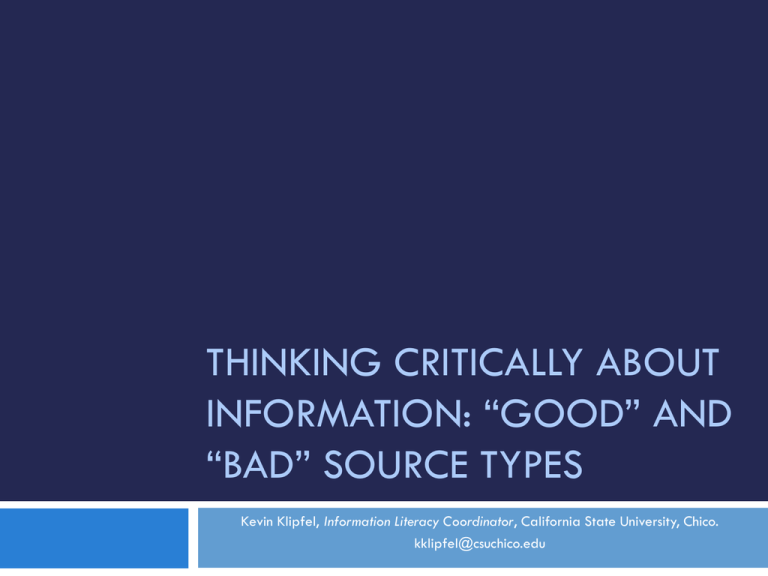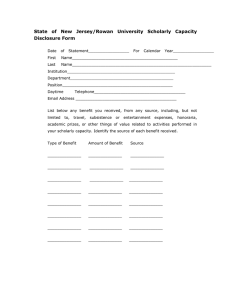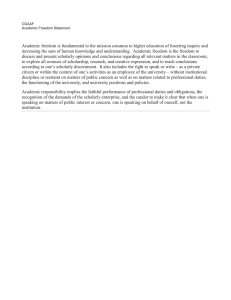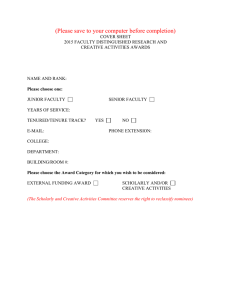THINKING CRITICALLY ABOUT INFORMATION: “GOOD” AND “BAD” SOURCE TYPES Information Literacy Coordinator
advertisement

THINKING CRITICALLY ABOUT INFORMATION: “GOOD” AND “BAD” SOURCE TYPES Kevin Klipfel, Information Literacy Coordinator, California State University, Chico. kklipfel@csuchico.edu Thinking Critically about Source Types Is this a “good” source? – Bad question. Is this the best source for my current purpose(s)? – Great question. Different types of information serve different purposes. So, the best resource for you to use really depends on what you’re looking for and where you’re at in the research process. Information Context: What is my purpose? When thinking about which type of source it’s best for you to use at a given time, ask yourself: What am I trying to do right now? Build my background knowledge on a particular topic I don’t know a whole lot about? Narrow down the scope of my topic? Define what is meant by a particular term? Provide evidence/support for something I just said in my paper? Argue for a more abstract, philosophical point? Using Sources is a Process It’s best to think of using sources as a process: a common beginning research mistake is to jump in to the research process at too specific a point too far down the line. For example: if you don’t know too much about your topic, it can be hard to start the research process with a peer-reviewed, scholarly article: the source will be technical, narrowly focused, and not the best source for your current purpose (building background knowledge). In order to better see which type of source you should use when, it’s worth getting clear about how information used in research tends to be packaged. Ways Knowledge is Packaged Knowledge Packaging: Encyclopedias Encyclopedias contain the most general kind of knowledge. You can use them to: Get started with your research. Build background knowledge by getting an overview of a topic. Narrow your research question (by seeing the ways the encyclopedia divides up a subject). Understand scholarly language related to your topic. Knowledge Packaging: Books Books will contain information that is general, but still more specific than an encyclopedia. You can use them to: Build background knowledge or in-depth understanding of a specific issue. Understand the scholarly or popular issues pertaining to a topic. Provide evidence for the claims you make in your paper. Note: You do not need to read an entire book to use it in your research! Sometimes just a part of the book, e.g., a particular chapter, will give you the information you need. Knowledge Packaging: “Popular” Articles Popular articles will be much more specific than encyclopedias or books. They will be aimed to entertain an audience; thus, they will be written in clear, understandable language. You can use them to: Build background knowledge on your topic. Find scholarly articles about recent scientific breakthroughs (e.g., The New York Times Science Section). Build an argument in your paper and cite them as evidence for your claims. Knowledge Packaging: “Scholarly” Articles Scholarly articles will be the most narrowly focused type of source: they’ll usually provide a high level of detail about an issue that’s very narrow in scope. You can use them to: Cite in your paper when you build an argument. They are the best kind of evidence to use as support for the claims that you make. Gain the best and most current understanding of your topic. Understand future research directions related to your topic. Some Rules of Thumb Encyclopedias: Popular Sources: Good to use when you’re trying to get a broad overview of a topic and figure out the terms scholars use in the scholarly literature, especially at the beginning of the research process. Not a bad source to use as a citation in you’re paper if you want to define a term. Good for building background knowledge about your topic, especially for recent scientific breakthroughs (e.g., The New York Times Science Section) in fairly easy-to-understand language. Also a good way to find more “scholarly” studies. May want to cite sparingly in your research (preferring, instead, to directly cite the scholarly articles on which the popular source is based). Scholarly Sources: The best kinds of sources to use as evidence in your paper, since they’re the most “reliable” and trusted kinds of sources. Can be a difficult place to start your research (because they’re written in complicated language) but, once you build your knowledge of a topic, it’s where you want to end up. Information Context: Remember your Purpose When thinking about which type of source it’s best for you to use at a given time, ask yourself: What am I trying to do right now? Build my background knowledge on a particular topic I don’t know a whole lot about? Narrow down the scope of my topic? Define what is meant by a particular term? Provide evidence/support for something I just said in my paper? Argue for a more abstract, philosophical point? Given your new understanding, when doing research you can now ask yourself: which source-type would best help me accomplish my purpose at this stage of my research? Contact a Librarian And if you’re having any trouble, don’t forget to contact a librarian: we’re more than happy to help! For questions about this module, or how to incorporate this module into specific courses, contact: Kevin Klipfel, Information Literacy Coordinator, California State University, Chico. Contact: kklipfel@csuchico.edu



